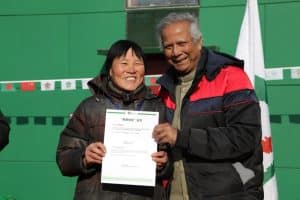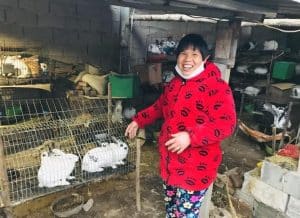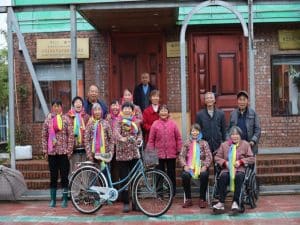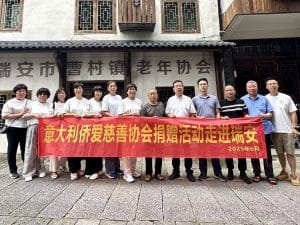Authors: Jayne Su, Leah Xu, Mark Zhao
Grameen Bank, founded by Nobel Peace Prize winner, Muhammad Yunus, is best known for its “Group of Five” model. It has helped millions of poor people around the world, with a particular focus on empowering women. In Xuzhou, Jiangsu Province, this model has demonstrated strong adaptability and a long-lasting impact on the poor. This group of five models is not only Grameen’s smallest lending unit, but also serves as the core mechanism for ensuring loan recovery and improving the socioeconomic conditions of its members.

Yunus with Grameen members from Lu Kou village in Beijing. Source: Grameen China
Foundation of Risk Control:
—The Group of Five Model Ensures Bank Operations
Grameen Bank’s group of five model effectively manages lending risks and ensures the long-term operational sustainability of its operations through a series of well-calibrated mechanisms.
Before receiving a loan, the group of five reduces the risk of default through social bonds between members, mutual familiarity, and peer pressure. “When forming the group, we ask members to recommend their friends, and the center manager accompanies the introducers on home visits.” Explains Manager Zhu, a Grameen China staff member. This structured referral mechanism fosters natural trust and understanding among group members, forming a strong social constraint that reduces the likelihood of default from the start.
Meanwhile, after attending five training sessions, members are required to participate in an assessment and certification. Staff double-check personal connections among members to prevent the formation of fraudulent groups intending to scam the bank. Five model further reduces fraud through a transparent information-sharing system. Members must explain their intended use of the loan at center meetings. As Mr. Liang, Grameen Xuzhou’s center manager, note; “By sharing their plans with the other four people and publicly presenting their loan usage, we can effectively prevent group fraud.” Collective supervision ensures full transparency in the lending process. Strong social ties allow members to quickly detect irregularities, thus reducing fraud risk.
After receiving the funds, the mutual support within the group helps strengthen members’ ability to repay. Sharing experiences among members is a key factor in this improvement. Ms. Wang from Wang Lou Town, Xuzhou, Jiangsu Province, states: “The techniques of raising rabbits were all taught by my ‘Grameen sisters’.” She now earns more thanks to the increased efficiency gained from their shared knowledge.

Grameen member Ms. Wang with her own rabbit farm. Source: Grameen China
Ms. Cao, from Lu Kou village, also noted that her group often discuss which crops would be most profitable. This information-sharing and mutual assistance—such as prioritizing the purchase of group members’ products—significantly increases members’ income, which in turn secures the bank’s repayment rate. According to the Grameen Center, the repayment rate at the Xuzhou Center in Jiangsu Province has consistently exceeded 98%, far above that of other local microfinance institutions.
In addition, the system requires that five members be active at all times, ensuring a stable number of borrowers. “For the system to operate, the group must have five members with no one missing,” said Gao Zhan, head of Grameen China. “If anyone leaves, they must recommend someone new to join, which helps maintain stability in our borrower base.”
Ms. Liu’s experience in Xuzhou confirms this: “We automatically look for replacements when we no longer need a loan, and the group naturally expands as our neighbors get involved.” This renewal membership maintains a stable client base, supporting Grameen’s long-term development.
Driving Changes:
—The Group of Five Model Empowers Rural Women
In Xuzhou, Jiangsu Province, many members reported that the Group of Five model not only provided financial resources but also enhanced emotional support, social networks, and a sense of self-worth.
Emotional Support
The Group of Five offers emotional support to rural members, reducing stress and anxiety. By joining the group, members engage in more meaningful conversations and open exchange of ideas. Ms. Liu from Lu Kou Village observed: “Usually we only chat after dinner, but since joining the group, we’ve become closer and now communicate during weekly meetings. Even in winter, whenever we have free time, everyone goes to the Grameen office to play cards together!” Mr. Liang, manager of the Grameen Center in Lu Kou village, remarked, “Rural women need empathy. They need someone to confide in and to express their emotions.” Members agreed that speaking with their “sisters” in the group was the best way to lift their spirits. “The biggest change since joining the group is that I’ve become more optimistic, I feel younger,” said Ms. Liu. Ms. Ji shared a similar view: “I used to feel bored at home. Now we meet weekly and chat—it brightens my mood. My husband supports it too; he thinks it’s good for me to talk things out.” Many members continue to attend meetings even without financial pressures to borrow. Ms. Ji said: “I don’t have a loan now, but I still go to meetings because they make me happy.” Ms. Wang added: “I have paid off my loan, but I still enjoy attending because the group gives me mental comfort and support.”

Grameen members smiled brightly after attending a group meeting of five. Source: Grameen China
Social Bonds and Mutual Aid
Socially, the Group of Five fosters deep connections, turning members into a true mutual-aid community. Members will agree on a fixed meeting time—no one should be late. If someone is over 10 minutes late, the meeting is canceled. “Being part of a group brings a sense of responsibility,” Gao explained. Seating is also fixed. “This small detail matters—if someone is unexpectedly absent, others notice right away and visit her afterward to check on her.
Each meeting begins with all members shouting the slogan: “Work Hard, Unite with Discipline.” Gao emphasized: “Chanting together reinforce simple habit. When members shout slogan in unison and with enthusiasm, it shows strong cooperation and group cohesion.”
These tight-knit connections translate into practical help. Ms. Liu recalled: “Once one of my sisters needed 1,500 yuan urgently for car repairs. I sent it to her right away. We’re in the same group—mutual help is natural.” Ms. Wang added: “Now we have a WeChat group. If someone needs business support, we prioritize buying from them.”
Members help each other by offering discounts, raising raise purchase prices, promoting each other’s products, assisting with farm work, and even getting better deals on home renovations. The Group of Five has transformed women’s social interactions into tangible life and business support.
Grameen convened a meeting in Lu Kou Village. Source: Grameen China
Personal Growth and Confidence
The Group of Five also encourages improvements in members’ personal image, home environment, and family status. Many women now dress up for meetings. “I used to be lazy at home and didn’t like to clean,” Ms. Wang said. “After joining the group, I started tidying up. Now my house is clean and I look better, too.”
Ms. Cao noted her confidence had grown:“I used to wear old clothes to do farm work, but before meetings I would dress up. That made me feel younger and more confident.” Changes extended to home renovations. “We used to have squat toilets—dirty and smelly,” said Ms. Wang. “After hearing about bathroom upgrades in group meetings, I decided to renovate mine. I spent over 10,000 yuan to do it.” Even household power dynamics shifted. “Grameen lends to women, so we’re in control. We borrow and repay ourselves—that gives us security,” Ms. Ji explained. “Grameen doesn’t lend to men, so they can’t use the money to smoke, drink, or gamble.”
Now, she leads her household’s finances: “I manage all our savings and loans. The Group of Five gave me the confidence to make that change. My sisters and Grameen Bank gave me this sense of security and support.”
Grameen member Ms. Ji Source: Grameen China
Challenges and Prospects:
—Difficulties and Lasting Value of Replicating the Model
Despite its effectiveness, the time and effort Grameen invests in forming and maintaining truly effective groups of five—such as frequent home visits, long-term training, and deep community integration—is beyond the reach of many organizations attempting to replicate the model.
Some banks, finding these efforts too complex, were discouraged from fully adopting or scaling up the Grameen model. At the same time, the model places high demands on Grameen’s staff. Center managers must not only embrace Grameen’s philosophy of long termism, but also demonstrate patience and the ability to integrate with grassroots communities. Yet the lasting significance of the Group of Give method goes beyond its operational challenges. It is not only an innovative financial tool but also a powerful way to build social capital and empower women at the grassroots—helping them shift from economic dependence to active participation and leadership in their communities. The implementation of this model in Xuzhou, rooted in community trust and women’s mutual assistance, offers valuable insights for promoting financial inclusion and rural development. As many members have said: “It was my friends in the group who gave me the courage to change.”
Thus, on the path toward grassroots empowerment, laying a solid foundation through meticulous work in the early stages may be essential for sustainable long-term progress.



